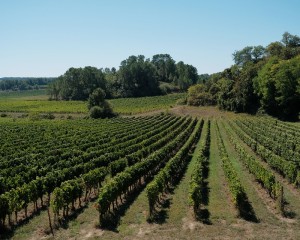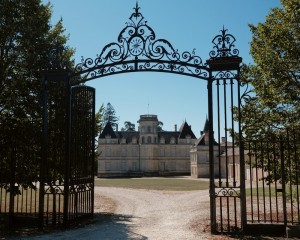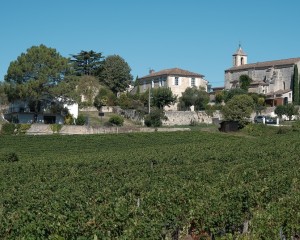Puisseguin is a town of the Great Saint-Emilion Area part of the canton of North Libourne. It is located at 7.4 km from Saint-Émilion and its area is 1,725 hectares. Today the town has 873 inhabitants, and they are called the Puisseguinais and the Puisseguinaises.
The town takes its name from puy, which means "mountain" and Seguin, who was one lieutenant of Charlemagne.
In the 14th century, Puisseguin is a small castle-dependent of Puynormand, and extending to Parsac. The Seguin family, really powerful family in the area during the Middle Ages settled on the site in the early 8th century and began to build a castle. In May 1341 the lordship of Puynormand, which depends of Puysseguin, is attributed to the Albret family, who kept it until the 17th century. During the Revolution, Saint-Pierre parish of Puisseguin formed the town of Puisseguin and Saint Martin Parish of Monbadon formed the town of Monbadon. On January 1st 1989 the municipality of Monbadon was related to that of Puisseguin.
The vineyards, cultivated since the Middle Ages, took off in the 18th century with the introduction of new varieties and under the influence of Pierre Combret de La Nauze who urged the potential of this terroir facing south. Since this moment it has received the AOC Puisseguin-Saint-Émilion.
The town of Puisseguin are crossed by various creeks : the Barbanne, the Palace, the Vanelle, the Rouille and the Bernon.
The appellation "Puisseguin-Saint-Emilion" covers 750 ha and is declined by the many chateaus and wine cooperatives installed on the town
Another label is present on 238 ha in the Monbadon sector; these are the "Castillon - Côtes de Bordeaux", formerly called "Côtes de Castillon".
To discover the territory, several biking and hiking routes are offered by the town to discover the heritage and themed routes.
The Tourist Office of the Great Saint-Emilion Area also offers the bike route "Churches and castles in Lussacais" starting from Montagne and last for 1h30.
The feudal castle Monbadon was built in the 14th century in the municipality of Monbadon-Puisseguin, originally watchtower. A real stronghold is then built to provide a line of defense with the castles of Malengin and Puisseguin between Castillon-la-Bataille and Puynormand. Since 1602, under the reign of Henri IV, King of France and Navarre, the same family still owns the entire field. Many lords, barons of Monbadon, succeed. Monbadon Castle now has a vineyard of 25 hectares and is one of the last testimonies of medieval military architecture remaining in Gironde.
Puisseguin Castle is a castle of the 14th century built in 1314. It still has defensive elements of time. The main façade presents some fortification elements: it is punctuated by two round towers crowned with battlements and surmounted by small towers with roofs shaped snuffer. Two doors of different sizes are used originally, one for cars and one for pedestrians.
The Saint-Martin Church was built in the early 11th century, preserved moldings testify to that time. His name is the name of a very popular saint in France, with almost 500 towns with this name and that about 4,000 churches dedicated to him. Its portal is Romanesque and the church has a sundial from 1630.
The Church of Saint-Pierre in essentially Romanesque architecture dates from the very end of the 12th century and has been modified and enlarged in the 15th century. All that remains of the first period that the lower part of the façade and the first two bays of the nave. In 1786, the church knows many transformations, the upper part of the façade was redone in modern times.
22 Avenue Beauséjour
33330 PUISSEGUIN
05 57 55 22 20
mairie.puisseguin@wanadoo.fr
OPENING DAYS OF THE CITY HALL
Monday to Thursday: 8:30 am to 12:30 pm and 1:30 pm to 5:30 pm
Friday: 8:30 am to 12:30 pm and from 1:30 pm to 4:30 pm

Grand Saint-Emilionnais Tourist Office
Le Doyenné - Place des Créneaux
33330 SAINT-EMILION





